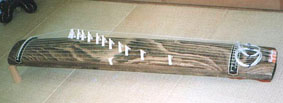|
 Koto has a very long
history. It was invented two thousand years ago during the
Sin dynasty in China. Koto with twelve strings and with
thirteen strings were born during the Zui dynasty and the
Tou dynasty. Koto with thirteen strings was introduced into
Japan and developed. There are three kinds of Koto in Japan.
They are named "Gakusou," "Chikusou," and "Zokusou." In
Konkokyo-Tengaku, Zokusou is used. Koto has a very long
history. It was invented two thousand years ago during the
Sin dynasty in China. Koto with twelve strings and with
thirteen strings were born during the Zui dynasty and the
Tou dynasty. Koto with thirteen strings was introduced into
Japan and developed. There are three kinds of Koto in Japan.
They are named "Gakusou," "Chikusou," and "Zokusou." In
Konkokyo-Tengaku, Zokusou is used.
The strings are stretched on the front of the body made of
paulownia. It is tuned by "Hashira" streching the string.
There are thirteen strings. Koto-zume (zume means nail) are
set into thumb, forefinger and middle finger of right
hand.
There is distinction among schools, for example
'Yatsuhasi-ryu', 'Ikuta-ryu',and 'Yamada-ryu' and so on.
Each school seems to have different shape of Koto zume. At
Konkokyo-Tengaku, we use 'Zohge-zume,' which is made of
ivory, in Kibigaku and 'Take-zume,' which is made of bamboo,
in Chuseigaku. Koto-zume is about one centimeter long and
the top width is about 7 millimeters.
|

